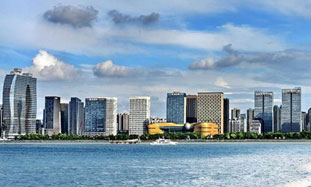Zhejiang's traditional manufacturing continues to develop smoothly

A worker operates a machine at a textile company in Huzhou, Zhejiang province. [Photo/VCG]
Traditional manufacturing in Zhejiang province showed strong development in the first three quarters of the year.
Statistics show that the value-added of the province's 17 traditional manufacturing industries above the designated scale (industries with annual revenue of more than $2.85 million) increased by 20.8 percent year-on-year during the period. Productivity of the 17 industries grew by 8.9 percent.
The growth can be partly attributed to the province's development and application of new devices and technologies.
From January to September, R&D expenditure of the 17 industries increased by 19.9 percent year-on-year, 0.9 percentage points higher than the provincial average for industries above the designated scale.
Zhejiang Qixing Electronics Co located in Meishan town, Changxing county, Huzhou invested 9.6 million yuan in developing new energy vehicles and 2.55 million yuan in attracting skilled workers.
Integration with the digital economy has injected new impetus into the province's traditional manufacturing. The new material intelligent manufacturing base built in Tongxiang by China Jushi Co, a leading Asian fiberglass manufacturer, has an intelligent control center that receives real-time production data to control the plants, which saves on labor costs and improves quality.
In the first three quarters, the new product output of the aforementioned 17 industries grew by 12.6 percent year-on-year. The province's traditional manufacturing sector now has more than 8,500 high-tech companies which contributed over 40 percent of the sector's output, 50 percent of the value-added and 60 percent of profit during the period.
In addition, the net profits of the traditional manufacturing sector in Zhejiang accounted for more than 60 percent of the total net profits produced by all industries above the designated scale, compared with 59.3 percent a year earlier.

 Print
Print Mail
Mail
 20 Cultural Symbols
20 Cultural Symbols Why Zhejiang
Why Zhejiang Experiencing high-tech products at WIC
Experiencing high-tech products at WIC Zhejiang Release
Zhejiang Release Zhejiang News
Zhejiang News